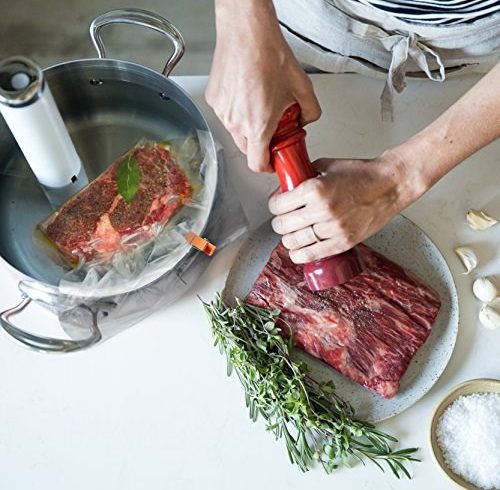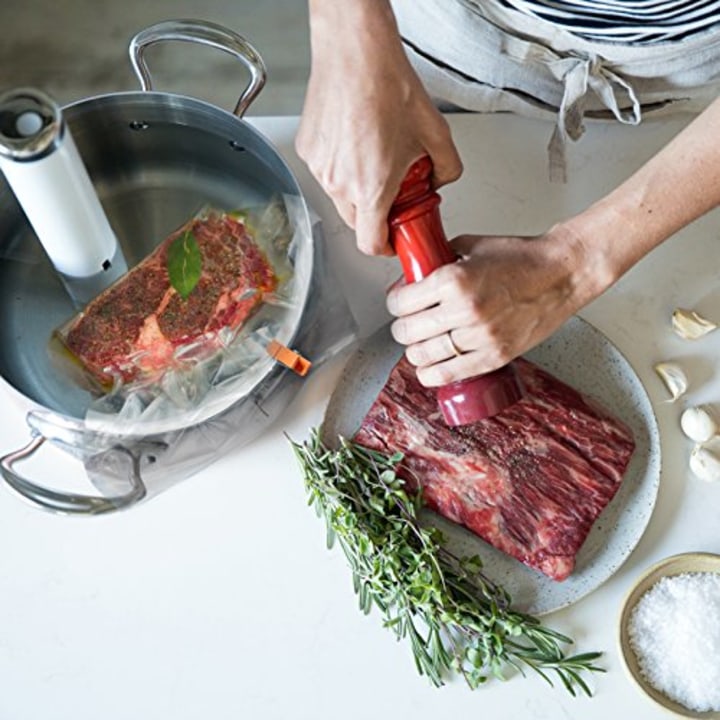I’ve been a big fan of my sous vide immersion cooker since I got one as a gift for Christmas in 2018. I can pop, say, a pork tenderloin in there midafternoon, work for a couple more hours while it cooks, then quickly sear it and serve it when it’s time for dinner.
But I work from home, so it’s easy for me to take a five-minute break to start dinner. That’s not so convenient if you want dinner on the table 20 or 30 minutes after you get home from work.
If you’re working at home for a few weeks now, or if you have older kids home who can help, it’s time to give sous vide cooking a try.
What’s so great about sous vide cooking?
Immersion cooking is most well-known for its ability to perfectly cook meat and fish.
Say you want to cook a steak medium rare. You pop it in the bag, squeeze most of the air out, and set it in a pot or pan of water. By heating it to 130 degrees for an hour, the meat will be perfectly pink all the way through. It never gets above 130 degrees, so it won’t overcook.
If you’re working late, or you need a few minutes to prepare a salad or some veggies, the steak can wait. All it needs is a sear for about a minute on each side to finish it.
There’s a lot more you can do with an immersion circulator
I’ve mostly used my sous vide machine to cook meat, especially expensive cuts I could easily overcook and ruin. But once I talked to Lisa McManus, executive tasting and testing editor for America’s Test Kitchen, I realized I could be doing a lot more with it:
Slow-cooked meats. “You can get the temperature and texture exactly right without worrying about it,” McManus says. “For pot roast, you can do a pink interior and have it be perfectly tender.” She says you can sear the meat first, add some aromatics to the bag, and use the juices left in the bag when the meat is done to make a quick sauce. Plan ahead though — you might want to slow-cook these cuts of meat for up to 24 hours.
Chicken breast. I’m usually not a fan of chicken breast, since more often than not it’s dry and bland. But sous vide cooking can keep it juicy and flavorful. You can sous vide and sear breasts for dinner, or sous vide up a batch and dice or shred them to add to dishes like salads and tacos during the week.
Veggies. Try green beans, bok choy, parsnips, potatoes, and other vegetables. “Carrots and asparagus get a beautiful, concentrated flavor without being diluted in the water,” McManus says. “They cook consistently and you’re not boiling off half the flavor.”
Eggs. From raw but pasteurized to hard-cooked and easy-to-peel, your sous vide cooker can perfectly prepare eggs. “Eggs are really easy to get exactly right,” McManus says.
Fancy desserts. You can cook desserts like crème brulee or chocolate pots de crème in individual mason jars and store them in the fridge for up to three days.
Ready to give it a shot? Try these recipes from the America’s Test Kitchen cookbook “Sous Vide for Everybody: The Easy, Foolproof Cooking Technique That’s Sweeping the World“.
Get the better newsletter.
Sous vide machine prices have dropped
McManus said that when sous vide cooking for home appeared about 10 years ago, machines cost around $500 and required quite a bit of counter space. Today’s machines can work with a pan or pot you already have, and you can store them in a drawer when you’re not using them.
America’s Test Kitchen tested sous vide machines and these two came out on top:
Breville Joule Sous Vide
Anova Precision Cooker Wi-Fi
And, if you’re in the market for an Instant Pot, the Duo Evo Plus 9-in-1 model ($120) includes a sous vide feature.
Other than the machine, you don’t need much equipment for sous vide cooking. You’ll want a stock pot, Dutch oven, or plastic container that can hold at least seven quarts — for larger cuts of meat you may want 12 quarts.
You can use a vacuum sealer for your sous vide, but you don’t have to — standard freezer bags work fine. And you’ll want some binder clips to attach the bags to the side of your container so they don’t float around.
Is sous vide cooking safe?
I’ll admit, it felt a little weird to me at first to be cooking at these relatively low temperatures. McManus explains something I didn’t know — that both temperature and time factor into food safety. With enough time, 130 degrees is hot enough to kill most food-borne pathogens.
Take chicken breast. We’ve all heard that we need to cook it to 165 degrees. McManus explains that at that temperature, Salmonella is killed immediately. At 160 degrees, Salmonella dies in 14 seconds. Drop to 155 degrees and it takes 50 seconds. America’s Test Kitchen recommends a 150-degree temp for perfectly cooked sous vide chicken — you just need to have your chicken at that temp for at least three minutes.
If your recipe calls for a cook temp below 130, searing the meat first will kill the pathogens on the food surface.
And what about cooking in plastic bags? The America’s Test Kitchen team reviewed the research and believes these bags are safe for sous vide cooking. Their favorite is Ziploc.
One food-safety caveat — don’t sous vide raw garlic. There’s a risk of botulism. Instead, add garlic at the end, or use granulated garlic powder.
More kitchen recommendations from BETTER
Want more tips like these? NBC News BETTER is obsessed with finding easier, healthier and smarter ways to live. Sign up for our newsletter and follow us on Facebook, Twitter and Instagram.
NBC News takes care to recommend our favorite items chosen by trusted













